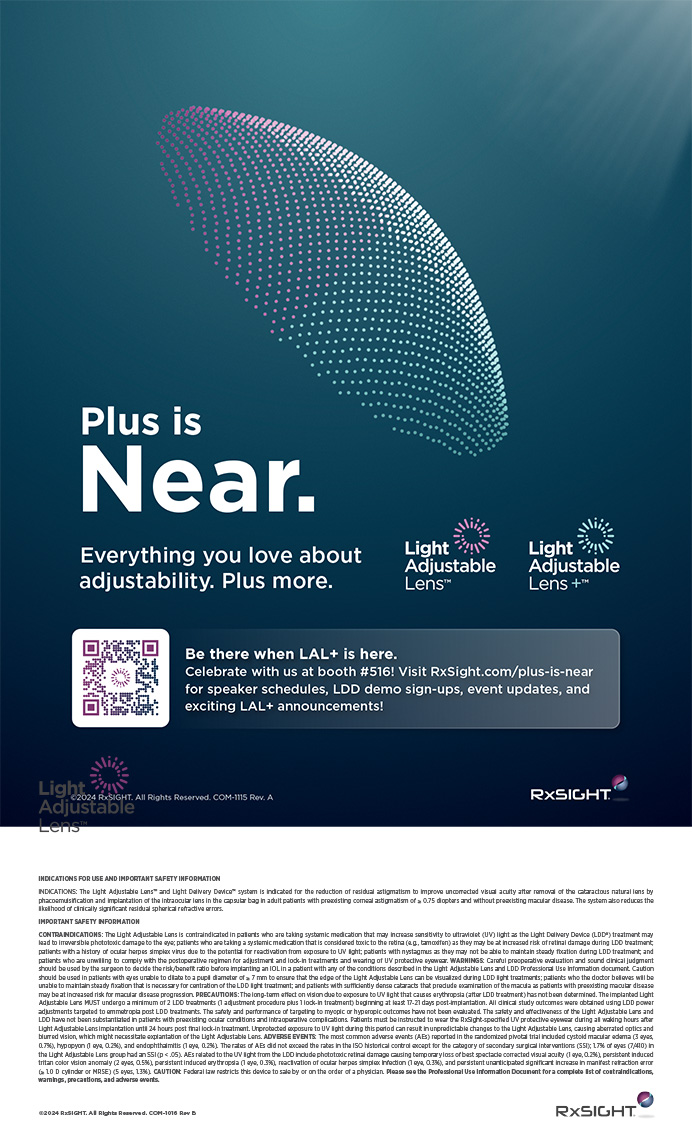Refinements in phaco techniques and technologies continue to optimize nuclear and cortical removal and enhance patients’ outcomes. Advances in IOL technology continue to allow for enhanced visual acuity.
TODAY’S PHACO PLATFORMS
Infiniti
I have recently used all three of the latest phaco plaforms. The Infiniti Vision System with Ozil IP (Alcon Laboratories, Inc., Fort Worth, TX) has surpassed my expectations. The unit has integrated the best of available cutting and fluidic parameters in a microcoaxial system that uses a 2.2-mm incision. I have found that torsional technology tremendously improves surgical efficiency by minimizing repulsion and maximizing followability. In addition, as the vacuum threshold is almost reached, the IP technology senses impending occlusion and adapts the energy delivery (ie, kicks in a longitudinal pulse) to carousel the nuclear piece at the phaco tip. This change optimizes the location of the nuclear fragments for shearing and allows for uninterrupted flow, ultimately making the chamber more stable. IP technology has decreased my surgical time as well as the amount of energy and irrigation used without compromising safety, efficiency, or patients’ outcomes.
Whitestar
The Whitestar Signature System with the Ellips FX handpiece (Abbott Medical Optics Inc., Santa Ana, CA) offers both longitudinal and transverse phacoemulsification and is a definite improvement over Ellips technology or purely longitudinal phacoemulsification, but I find that this platform still has occasional issues with chamber instability and chatter. The technology has improved followability, holdability, and overall performance compared with earlier units, although a 2.7-mm incision is required.
Stellaris
The Stellaris Vision Enhancement System (Bausch + Lomb, Rochester, NY) allows me to perform 1.8-mm microcoaxial surgery with good control of fluidics and the chamber. I find that the unit occasionally has issues with repulsion due to the use of purely longitudinal phacoemulsification in short bursts.
IRRIGATION/ASPIRATION AND IOLS
For irrigation and aspiration of cortical material and viscoelastic, I highly recommend a silicone or polymer I/A tip with a silicone sleeve, like the MicroSmooth Irrigation Sleeve (Alcon Laboratories, Inc.). These tips are gentle on the capsule and allow for unsurpassed chamber control with a unique flange that ensures appropriate forward flow.
IOLs and Astigmatic Correction
As for IOL technology, I am using the AcrySof platform (Alcon Laboratories, Inc.) for about 40% of my cases. In my experience, the AcrySof IQ, a negative-aspheric IOL, achieves good outcomes in terms of patients’ functional vision. I now use the AcrySert C (Alcon Laboratories, Inc.) preloaded IOL inserter. This single-use device reduces and/or eliminates problems related to handling and sterilization. Unfortunately, it requires a 2.65-mm incision.
To correct preexisting astigmatism, I typically use the AcrySof IQ Toric IOL. I have found that the IOL behaves in a predictable manner and has excellent rotational stability. It is the most precise and reliable way to correct astigmatism at the time of surgery.1 The T3 to T5 models correct 1.00 to 2.06 D of corneal astigmatism. In Canada, surgeons also have access to the T6 to T9 models of the AcrySof Toric IOL (not aspheric), which correct 2.50 to 4.00 D of corneal cylinder. In my experience, it is at these ranges that patients are the happiest and the IOL’s stability greatly surpasses that of limbal relaxing incisions.
To accurately mark the cornea in the preoperative area, I now use the Davis Preview System (Mastel Precision, Inc., Rapid City, SD). Also from Mastel, the Davis Plumbob Marker is weighted and has four fins that outline the cardinal references easily and accurately. This device is used with the company’s Axis Glasses that give a target for the patient to fixate on plus 2X magnification. I can align the mark with the visual axis by way of an LED-generated corneal light reflex. Intraoperatively, I use the Gimbel-Mendez ring and the Bores Meridian Marker (both from Mastel Precision, Inc.) to mark the axis of astigmatism.
For presbyopic correction, I am currently using the AcrySof IQ Restor IOL +3.0 D for the majority of cases. I find that this lens delivers a high-quality range of vision, which is important, because most of my patients do not want to compromise their vision at any distance. This IOL is currently the only 3.00 D add lens available. The lens’ apodized diffractive optic is designed to work synergistically with the pupil to direct light energy at the needed focal point, depending on lighting conditions. This design also reduces the likelihood of visual disturbances, and I have received few complaints from patients about glare or halo with this IOL.
CONCLUSION
I expect continued advances in IOL technology and cataract surgical technologies. As the era of femtosecond technology dawns, it is a stimulating and rewarding time to be a cataract surgeon.
Rosa Braga-Mele, MD, MEd, FRCSC, is the director of the cataract unit at Mount Sinai Hospital, an associate professor at the University of Toronto, and director of research at Kensington Eye Institute in Toronto. She is a consultant to Abbott Medical Optics Inc.; Alcon Laboratories, Inc.; and Bausch + Lomb. She acknowledged no financial interest in any of the products mentioned herein. Dr. Braga-Mele may be reached at (416) 462- 0393; rbragamele@rogers.com.
- Minigo-Botin D,Munoz-Negrete F,Won Kim HR,et al.Comparison of toric intraocular lenses and peripheral corneal relaxing incisions to treat astigmatism during cataract surgery.J Cataract Refract Surg.2010;36(10):1700- 1708.


